Zhi Deng
RigGS: Rigging of 3D Gaussians for Modeling Articulated Objects in Videos
Mar 21, 2025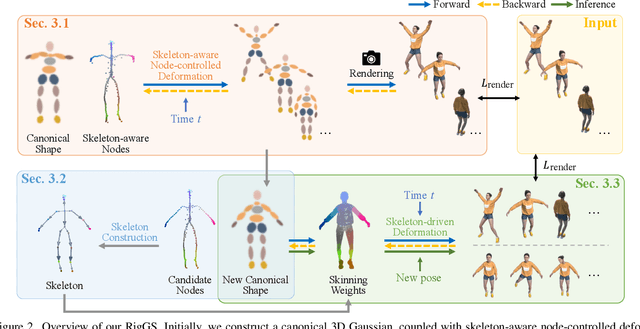


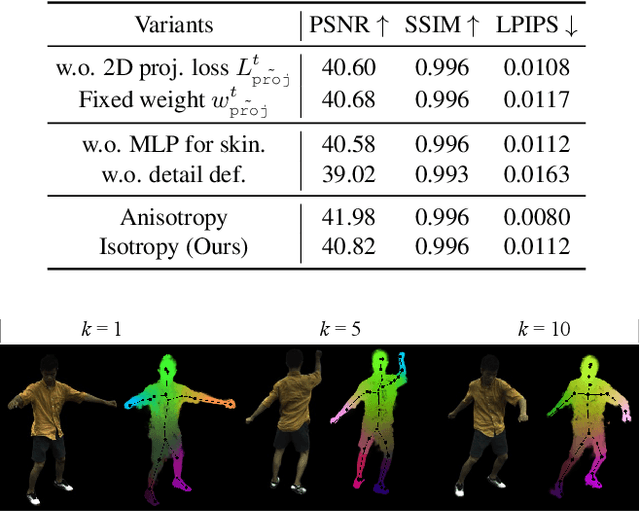
Abstract:This paper considers the problem of modeling articulated objects captured in 2D videos to enable novel view synthesis, while also being easily editable, drivable, and re-posable. To tackle this challenging problem, we propose RigGS, a new paradigm that leverages 3D Gaussian representation and skeleton-based motion representation to model dynamic objects without utilizing additional template priors. Specifically, we first propose skeleton-aware node-controlled deformation, which deforms a canonical 3D Gaussian representation over time to initialize the modeling process, producing candidate skeleton nodes that are further simplified into a sparse 3D skeleton according to their motion and semantic information. Subsequently, based on the resulting skeleton, we design learnable skin deformations and pose-dependent detailed deformations, thereby easily deforming the 3D Gaussian representation to generate new actions and render further high-quality images from novel views. Extensive experiments demonstrate that our method can generate realistic new actions easily for objects and achieve high-quality rendering.
DynoSurf: Neural Deformation-based Temporally Consistent Dynamic Surface Reconstruction
Mar 18, 2024



Abstract:This paper explores the problem of reconstructing temporally consistent surfaces from a 3D point cloud sequence without correspondence. To address this challenging task, we propose DynoSurf, an unsupervised learning framework integrating a template surface representation with a learnable deformation field. Specifically, we design a coarse-to-fine strategy for learning the template surface based on the deformable tetrahedron representation. Furthermore, we propose a learnable deformation representation based on the learnable control points and blending weights, which can deform the template surface non-rigidly while maintaining the consistency of the local shape. Experimental results demonstrate the significant superiority of DynoSurf over current state-of-the-art approaches, showcasing its potential as a powerful tool for dynamic mesh reconstruction. The code is publicly available at https://github.com/yaoyx689/DynoSurf.
Label-free timing analysis of modularized nuclear detectors with physics-constrained deep learning
Apr 28, 2023Abstract:Pulse timing is an important topic in nuclear instrumentation, with far-reaching applications from high energy physics to radiation imaging. While high-speed analog-to-digital converters become more and more developed and accessible, their potential uses and merits in nuclear detector signal processing are still uncertain, partially due to associated timing algorithms which are not fully understood and utilized. In this paper, we propose a novel method based on deep learning for timing analysis of modularized nuclear detectors without explicit needs of labelling event data. By taking advantage of the inner time correlation of individual detectors, a label-free loss function with a specially designed regularizer is formed to supervise the training of neural networks towards a meaningful and accurate mapping function. We mathematically demonstrate the existence of the optimal function desired by the method, and give a systematic algorithm for training and calibration of the model. The proposed method is validated on two experimental datasets. In the toy experiment, the neural network model achieves the single-channel time resolution of 8.8 ps and exhibits robustness against concept drift in the dataset. In the electromagnetic calorimeter experiment, several neural network models (FC, CNN and LSTM) are tested to show their conformance to the underlying physical constraint and to judge their performance against traditional methods. In total, the proposed method works well in either ideal or noisy experimental condition and recovers the time information from waveform samples successfully and precisely.
PulseDL-II: A System-on-Chip Neural Network Accelerator for Timing and Energy Extraction of Nuclear Detector Signals
Sep 02, 2022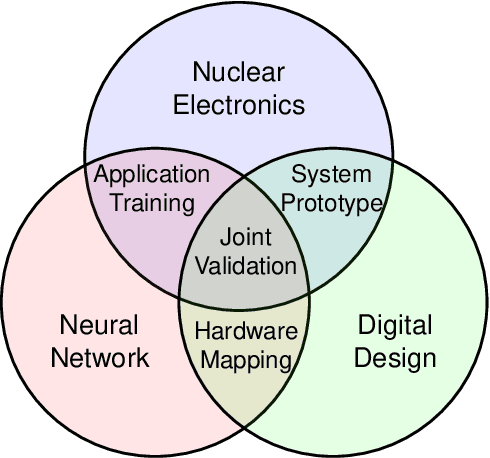
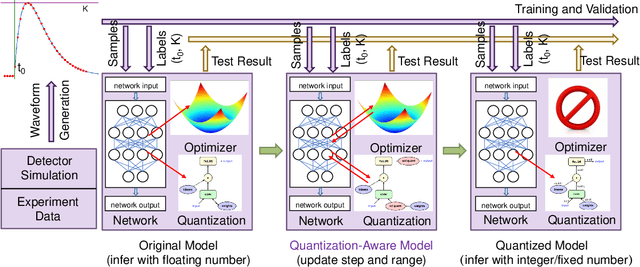
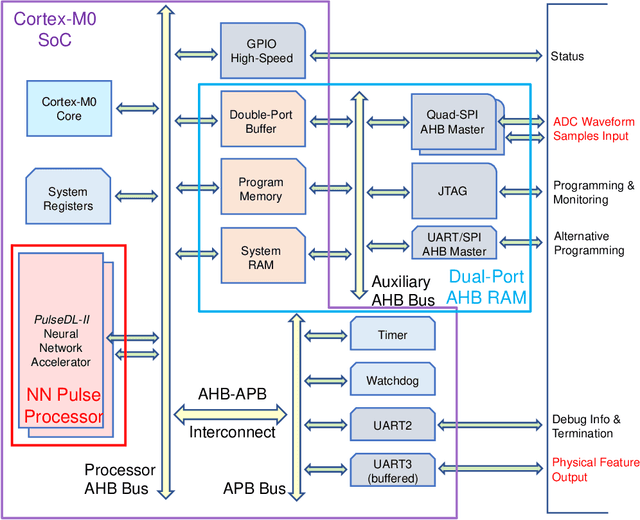
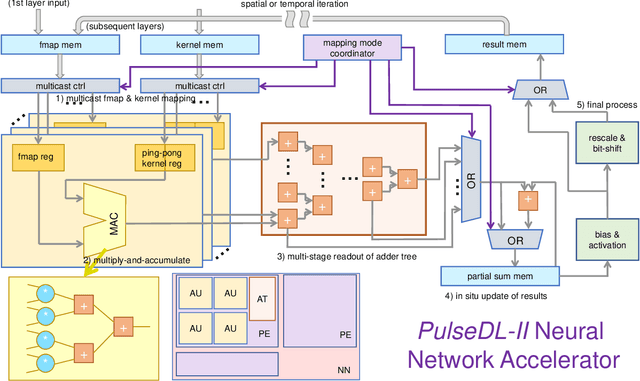
Abstract:Front-end electronics equipped with high-speed digitizers are being used and proposed for future nuclear detectors. Recent literature reveals that deep learning models, especially one-dimensional convolutional neural networks, are promising when dealing with digital signals from nuclear detectors. Simulations and experiments demonstrate the satisfactory accuracy and additional benefits of neural networks in this area. However, specific hardware accelerating such models for online operations still needs to be studied. In this work, we introduce PulseDL-II, a system-on-chip (SoC) specially designed for applications of event feature (time, energy, etc.) extraction from pulses with deep learning. Based on the previous version, PulseDL-II incorporates a RISC CPU into the system structure for better functional flexibility and integrity. The neural network accelerator in the SoC adopts a three-level (arithmetic unit, processing element, neural network) hierarchical architecture and facilitates parameter optimization of the digital design. Furthermore, we devise a quantization scheme and associated implementation methods (rescale & bit-shift) for full compatibility with deep learning frameworks (e.g., TensorFlow) within a selected subset of layer types. With the current scheme, the quantization-aware training of neural networks is supported, and network models are automatically transformed into software of RISC CPU by dedicated scripts, with nearly no loss of accuracy. We validate PulseDL-II on field programmable gate arrays (FPGA). Finally, system validation is done with an experimental setup made up of a direct digital synthesis (DDS) signal generator and an FPGA development board with analog-to-digital converters (ADC). The proposed system achieved 60 ps time resolution and 0.40% energy resolution with online neural network inference at signal to noise ratio (SNR) of 47.4 dB.
Sketch2PQ: Freeform Planar Quadrilateral Mesh Design via a Single Sketch
Jan 23, 2022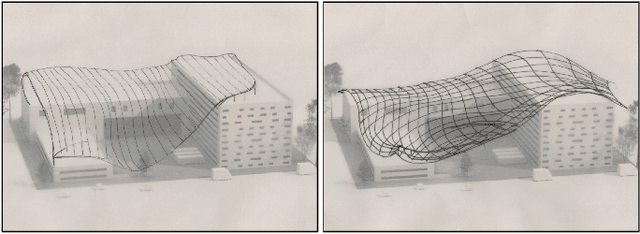



Abstract:The freeform architectural modeling process often involves two important stages: concept design and digital modeling. In the first stage, architects usually sketch the overall 3D shape and the panel layout on a physical or digital paper briefly. In the second stage, a digital 3D model is created using the sketching as the reference. The digital model needs to incorporate geometric requirements for its components, such as planarity of panels due to consideration of construction costs, which can make the modeling process more challenging. In this work, we present a novel sketch-based system to bridge the concept design and digital modeling of freeform roof-like shapes represented as planar quadrilateral (PQ) meshes. Our system allows the user to sketch the surface boundary and contour lines under axonometric projection and supports the sketching of occluded regions. In addition, the user can sketch feature lines to provide directional guidance to the PQ mesh layout. Given the 2D sketch input, we propose a deep neural network to infer in real-time the underlying surface shape along with a dense conjugate direction field, both of which are used to extract the final PQ mesh. To train and validate our network, we generate a large synthetic dataset that mimics architect sketching of freeform quadrilateral patches. The effectiveness and usability of our system are demonstrated with quantitative and qualitative evaluation as well as user studies.
A Robust Loss for Point Cloud Registration
Aug 26, 2021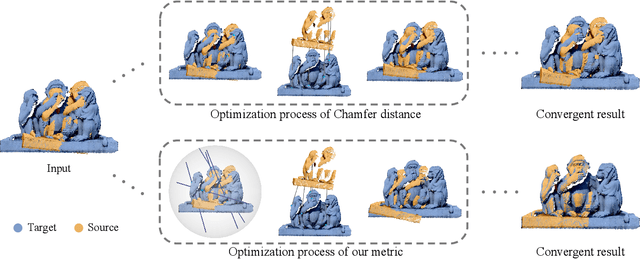
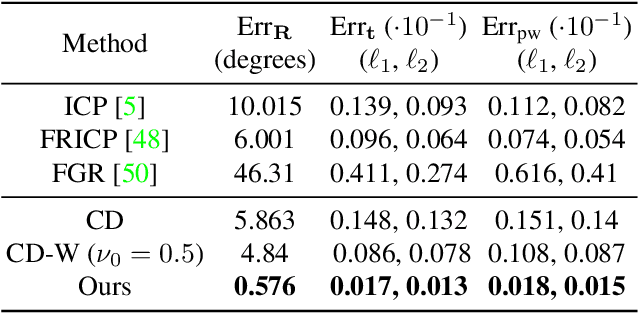
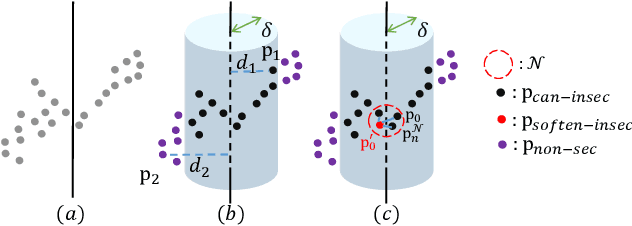
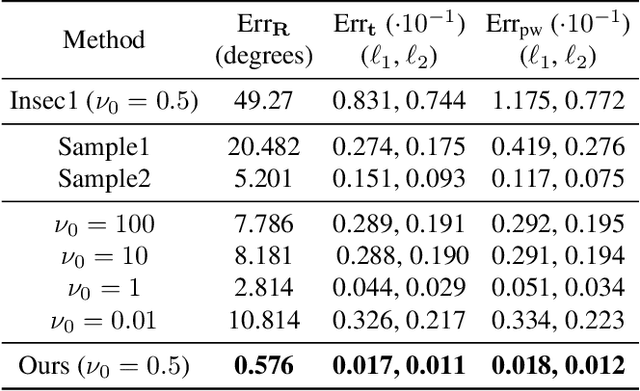
Abstract:The performance of surface registration relies heavily on the metric used for the alignment error between the source and target shapes. Traditionally, such a metric is based on the point-to-point or point-to-plane distance from the points on the source surface to their closest points on the target surface, which is susceptible to failure due to instability of the closest-point correspondence. In this paper, we propose a novel metric based on the intersection points between the two shapes and a random straight line, which does not assume a specific correspondence. We verify the effectiveness of this metric by extensive experiments, including its direct optimization for a single registration problem as well as unsupervised learning for a set of registration problems. The results demonstrate that the algorithms utilizing our proposed metric outperforms the state-of-the-art optimization-based and unsupervised learning-based methods.
 Add to Chrome
Add to Chrome Add to Firefox
Add to Firefox Add to Edge
Add to Edge